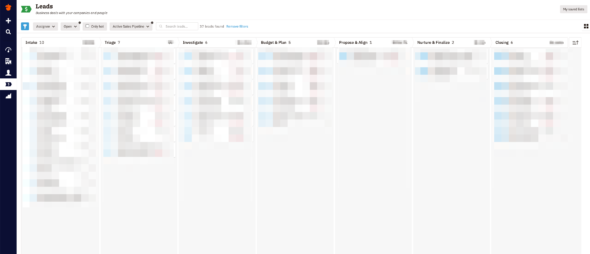Over the past year, we’ve done extra work on our company processes and practices. We’ve been fortunate — Atomic has a diverse set of clients and more demand than we can adequately supply. That said, there’s always room for improvement, and during these tough economic times, we’ve focused especially on improving our sales process.
Part of that work has been clarifying and refining the various stages we move through with prospective customers. Our sales process is designed to help us efficiently learn about potential projects so we can give clients the best advice possible — even when that advice is “building custom software isn’t the right choice for your project” or “here’s another agency that might fit your needs better.” Our goal is to provide value, even if we aren’t a fit for the project.
A Note on Tooling
We use Nutshell as our CRM because it’s highly customizable and a great fit for our needs. In our pipeline, sales leads are created in the “Intake” stage and moved from left to right through each stage, signified by columns:

At each stage, leads are given a dollar value and a confidence weighting. The dollar value is simply our understanding of the size of the project. The confidence weighting reflects how confident we are in winning the sale. Our sales tech updates the dollar value and confidence weighting as leads move through the pipeline. Generally speaking, a lead’s confidence rating increases as it moves left-to-right. Sales leads that we didn’t win are deleted and removed from the pipeline.
We named our pipeline stages using verbs to indicate the actions our sales team takes during that stage.
1. Intake
Goals: Be responsive to the client; schedule a triage call with the most appropriate Managing Partner.
Weighting Range: 0%
2. Triage
Goals: Understand the client’s needs, get to know the client as a person, and determine if the client and their project are a good fit for Atomic. If they’re not a good fit, be honest and (if possible) provide an alternative recommendation to custom software or Atomic. If they are a good fit, move to the next step.
Weighting Range: 0%
3. Investigate
Goals: Gain enough understanding about the client’s needs, pain, and motivations to:
- Share a compelling story of how Atomic can help.
- Create a budget model and project plan.
Continue to ask qualifying questions!
Weighting Range: 10-50%
4. Budget and Plan
Goals: Create a well-thought-out budget model and project plan.
Weighting Range: 10-50%
5. Propose and Align
Goals: Share a convincing and relevant narrative of how working with Atomic will satisfy the client’s near-term needs and create a long-term positive relationship.
Share the budget model and project plan with the client; adjust as appropriate and necessary to win work. Demonstrate a high degree of professionalism and business acumen.
Clearly set the next steps for locking in our project team. (If we are tentatively selected, continue moving through contract execution.)
Weighting Range: 10-70%
6. Nurture and Close
Goals: Proactively stay in touch to keep the opportunity alive, remove blockers, and execute the relevant contract documents. Set reminders to follow up with the client, based on their stated decisionmaking timeline.
Weighting Range: 10-90%
7. Close
Goals: Update and store key information and documents. Make sure the client and team know the next steps for kicking off the project.
Weighting Range: 100%
Final Thoughts
Selling custom software services is complex and challenging work. Not every project goes through all of the above pipeline steps; for example, we may start at the “Nurture and Finalize” step for an existing client who wants to extend an engagement. That said, our sales pipeline provides an essential scaffolding for our sales team and is very valuable when onboarding new Managing Partners.

